WANSTEAD.
ART AND HISTORY SITES ON FREE PUBLIC VIEW
| Various suggestions have been made for the origin of the name Wanstead. 'Stead' seems to come from the Old English 'stede' meaning 'place' or 'house of'; but 'Wan' has been suggested as being (a) wan meaning white (b) 'wen' meaning a hill (c) 'waen' meaning a wagon (as in Constable's 'Haywain') (d) Shortened form of Woden, the Norse God. Wanstead is mentioned in the Domesday Book as a manor previously held by St Paul (later known as St Paul's Cathedral) but at the time of the survey belonging to Ranulf Fitz Brien. Wanstead was described as having a manor house, a large area of woodland and one mill and was valued at 40 shillings (£2) For the origin of Leytonstone see Leyton Stone |
PUT MOUSE OVER  TO READ NAME
TO READ NAME
CLICK ON  FOR PHOTO & EXPLANATION.
FOR PHOTO & EXPLANATION.
FULL ALPHABETICAL INDEX OF ALL PAGES |
CONTENTS1. Cherry Pie 2. Churchill Memorial 3. Clock Court 4. Coppiced Tree 5. The Cuckfield Mural 6. Drinking Fountain 7. "The Eagle" 8. George III 9. Grotto 10. The Manor House 11. Pargetting 12. St Mary the Virgin 13. Snaresbrook Crown Court 14. "Spring" 15. The Temple 16. Tree With A Post Code 17. United Reformed Church 18. Wanstead House Gardens 19. Wanstead House Gate Posts 20. Wanstead War Memorial 21. Watching for Body-Snatchers 22. Witch's Tree |
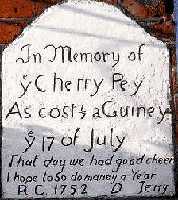 |
Cherry Pie. | |
The George Hotel, Kingfisher Avenue, facing Wanstead tube station. When this public house was rebuilt an inscribed stone was preserved and is visible on the Southern wall on the exterior of the building . This records the fact that one of the workmen in 1752 stretched out his hand and stole a cherry pie from a passing baker. The magistrate found him guilty and fined him half a guinea (52.5 pence). As the inscription is in the form of a rhyming verse, some poetic licence may have been involved and this might affect it's accuracy. (See No. 1. on Map ) Note: Although this story is very popular in the area, it may not be true. It is hard to imagine that anybody had much "good cheer" left after being hauled up before a beak and fined half a guinea. According to Wikipedia, a more plausible, if less amusing, explanation is that it commemorates a giant pie baked for a festival. |
||
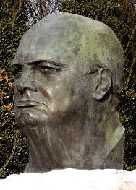 |
Churchill Memorial. | |
Sculptured head of Sir Winston Churchill, member of parliament for Wanstead and Woodford constituency, and Prime Minister 1940-45 and 1951-52. The sculpture is outside the Allied Irish Bank in Wanstead High Street which used to be the Conservative constituency office. The stone base of the statue was originally part of the old Waterloo Bridge. There is another statue of Churchill in Woodford. (See No. 2. on Map ) Artist Luigi Fironi. 1968. |
||
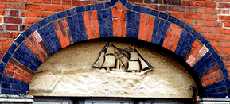 |
Clock Court. | |
Victory Road, Hermon Hill. The large building was erected in 1861 when Prince Albert the husband of Queen Victoria laid the foundation stone. Originally it was used as an orphanage for the children of British Merchant Seamen who died at sea. In 1919 the building was taken over by the Convent of the Good Shepherd, and in 1937 its use changed again and it became Wanstead Hospital, this was eventually closed and in 1996 it was converted into flats. On the front of No. 45 there are three relief carvings showing ships of the period when it was built. The one shown here, although damaged, is of particular interest as it depicts a vessel under sail, but with a large funnel amidships. This shows that it also had a steam engine aboard. There is a fourth and larger carving over the main front door of the flats together with an inscription commemorating Prince Albert's visit. (See No. 3. on Map ) Sculptor Thomas Earp. |
||
 |
Coppiced Tree. | |
In the park area just off Wanstead Place, and just south of Christ Church. This tree shows a very odd form of growth as result of coppicing. It was at one time common practice to cut off the main trunk of trees and so stimulate the growth of a number straight equal-sized shoots. In early times, the branches thus produced were used for building Tudor houses. planking for ships, charcoal-making, wattle fences and hop poles, etc. Later, in Essex they were often used for firewood and for such things as bean poles, etc. The branches of this tree were never harvested and after at least half a century, the boughs are twisted and have sometimes joined together. (See No. 4. on Map ) |
||
 |
The Cuckfield Mural. | |
On the corner of Wellington Road and the High Street. The restaurant called the Cuckfield may get its name from:
|
||
  |
Drinking Fountain. | |
Now standing on the corner of the green (once a cricket pitch), it is opposite Wanstead underground station by the traffic lights. Built 1897 to commemorate Queen Victoria's diamond jubilee, the fountain used to stand in the middle of the road junction and was a focal point of the village. Road developments forced the moving of the fountain. This fountain was designed to be similar to the fountain at the Snaresbrook end of the High Street, which had been erected in 1872. The sculpture of Queen Victoria is on the north side of the jubilee fountain and she is facing her grandfather George III. The Latin quotation on the south side is from Proverbs ch. 3, v. 16 meaning "Length of days are in her right hand and in her left hand (riches and) honour". They deliberately omitted reference to the Queen's wealth. Presumably, they used a classical language to disguise the omission, but it is still strange that they did not use the original Hebrew. During World War II, underneath where this fountain now stands, there used to be a factory involved in important war work. The tunnels for the Central Line had been dug as far as Gants Hill, but no track had been laid. When the Plessey works in Ilford were bombed, the production line for radio parts was moved into the tunnels for safety. The size of the operation was such that at times more than 2000 people worked here, and it was equipped with a canteen seating 600. (See No. 6. on Map ) |
||
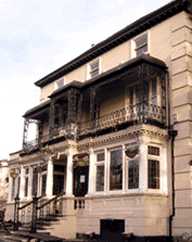 |
The Eagle. | |
The Eagle Public House is on Hollybush Hill opposite the traffic lights at the junction with Snaresbrook Road. It's name appears on map of 1777, but it is a much older. This pub was originally called the Spread Eagle and a pub has stood here since at least the seventeenth century. The present only building goes back to the eighteenth but the frontage does have some decorative cast iron around the balcony. (See No. 7. on Map ) | ||
 |
George III. | |
The George, the corner of Wanstead High Street opposite Wanstead Underground station. High above the front is a representation of King George III. He is looking down on his granddaughter Queen Victoria. Inside the pub there is a collection of pictures and posters illustrating the Hanoverian period of the Georges. This may be seen free of charge, but you will probably wish to purchase a drink while viewing. George III reigned from 1760 - 1820. He is remembered for being the king against whom the American colonists rebelled to secure their independence. In later life he suffered from bouts if mental illness, probably caused by porphyria. This pub shows an example of reincarnation, for in the 1716 it was called the George and Dragon. Some time in its history, it discarded the dragon and became Hanoverian. If they had kept the old title together with the present royal portrait, then Queen Charlotte would presumably have been cast as the dragon. The present building dates from before 1902. (See also the Cherry Pie inscription. For the George, see No. 8. on Map ) |
||
 |
Grotto. | |
In Wanstead Park on the edge of one of the ornamental lakes there is a structure in the form of a grotto with a small inlet behind as it was later used as a boat house. It was built in 1761 in the grounds of the once great Wanstead House. But in 1884, two years after it was opened to the public, it was almost destroyed by a fire and only part of the frontage remains. It was once spectacular and was described as having "a domed roof encrusted with pebbles, shells, stalactites, crystals and looking glasses." The present structure is still a picturesque ruin and serves as a reminder of the grottos built on large estates in the eighteenth and nineteenth centuries. The ponds date back to the 17th century. The artificial islands in this pond were used to stage spectacles when members of the staff dressed up and enacted mock battles for the entertainment of guests at Wanstead House. (See No. 9. on Map ) |
||
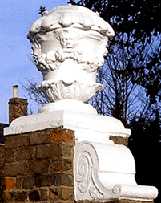 |
The Manor House. | |
Gateposts of the Manor House, now the Allied Irish bank have been preserved and can be seen in the High Street flanking the frontage of the property. Between here and the George there used to stand a house which might have been the home of Admiral Sir William Penn, the father of William Penn, the founder of Pennsylvania. Pepys records that the admiral was planning to buy it, but it is not clear whether he completed the purchase. (See No. 10. on Map ) |
||
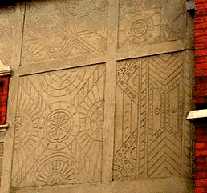 |
Pargetting. | |
The Corner House at the junction of Grove Park and Wanstead High Street. Pargetting is the name for the practice of making quick designs in the cement or clay on the outside of buildings before it has had time to set or dry. This was a commonly done in parts of Essex. Saffron Walden has many fine examples of the craft. (See No. 11. on Map ) |
||
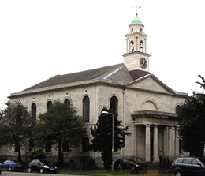 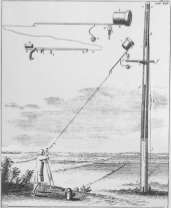 |
Church of St Mary the Virgin. | |
Overton Drive opposite St Mary's Avenue. The present Church was rebuilt in 1787 on the site of an older building. The first recorded Rector was in 1207 but there was a church here before that date. The reconstruction was paid for by Sir James Tilney, owner of the neighbouring Wanstead House. (See also Watching for Body-Snatchers.) One of the rectors of this church was James Pound who in the early 18th century appointed his nephew, James Bradley, as curate. Both of them took an interest in astronomy. Isaac Newton gave Pound a very large telescope made by Christian Huygens. This probably stood on the present golf course from 1717 to 1747. An early illustration shows the telescope as having two lenses without a connecting tube, the front one was supported on a pole about 125 foot (40 metres) long, which made it the biggest telescope in Europe. The long pole had previously been used as a maypole in the Strand. Bradley used a smaller telescope and with this he discovered the slight "wobble" of the earth due to the gravitational effect of the moon. He eventually became the third Astronomer Royal. (See No. 12. on Map) |
||
 |
Snaresbrook Crown Court. | |
Main entrance in Hollybush Hill, but was designed to be viewed from Snaresbrook Road looking across the Eagle Pond. One can get a much closer view of the building by committing a crime in the area and as a result being summoned to attend the court. The building was erected as the Infant Orphan Asylum. It was officially opened in 1843 by King Leopold of Belgium. In 1938 it became the Royal Wanstead School. It was designed by Gilbert Scott and William Moffat. ( See 13. on Map ) | ||
 |
"Spring". | |
Sculpture in the entrance hall of Wanstead Public Library in Spratt Hall Road. This shows a nude woman and infant children. It was probably a plaster cast prepared before being cast in bronze. It was presented to the library in 1975. ( See 14. on Map ) Sculptor: Christine Gregory. Date: c. 1920s. (See also Edith Kerrison Memorial by the same artist) |
||
 |
The Temple. | |
The Temple is in the middle of Wanstead Park and is the only building still standing that was associated with Wanstead House. It was not a Temple but a place for banqueting and entertainment. It dates from before 1830. There had been a Roman villa nearby. When building work was carried out on Wanstead House in the 18th century a mosaic was found measuring 20 foot by 16 foot depicting a man and a horse; but at that time they did not think that it was something that they ought to preserve. There had been a large house in this area from at least 1520, when it was the manor house. It was a suitable place for the gentry to meet and go hunting in Epping Forest. At one time it was owned by Robert Dudley, Earl of Leicester and Queen Elizabeth I stayed here on more than one occasion. It was at Wanstead House where Elizabeth greeted her sister Mary Tudor when the latter was on her way to London to be crowned. The house was rebuilt by successive owners and was a magnificent structure with large ornamental gardens, but by the mid nineteenth century it fell into neglect and was demolished. (See No. 15. on Map ) | ||
 |
Tree With A Post Code. | |
The Green, Wanstead. This fragment of tree trunk was once a majestic Spanish Chestnut tree situated on the boundary of the cricket pitch on the Green. In the early 1990s, when plans for building the link road between the M11 and the A102 to the Blackwall Tunnel were finally agreed, this tree was featured on the front of national newspapers. Great anger was caused by the compulsory purchase of hundreds of homes in Leytonstone and Wanstead, and their destruction to make way for a road. The campaign against building the new road attracted protesters from all over the country. Amongst other things, in 1993, they built a house in the tree, and lived there, to hamper demolition. Because of the publicity, letters addressed to them at the tree were delivered by postmen. (Though, to be accurate, no post code was allotted to them.) The positive result of the protest was that public opinion forced the building of a tunnel under the Green, so that Wanstead is quieter today than it would have been. The negative result was that the aggressive tactics of some protesters forced the installing of security devices which increased the cost of the road to British taxpayers by several million pounds. As a memorial to the conflict, the tree was left in its original position above the now busy underpass. There are four other old chestnut trees standing in a straight line along the eastern edge of the Green. These are probably more than 275 years old. A map of the grounds of Wanstead House, dated 1735, shows an avenue of trees going from St Mary's Church to the Eagle Pond. On each side of the avenue was a double row of trees. They could have been Spanish Chestnuts as these can live to a great age. (See No. 16. on Map.) |
||
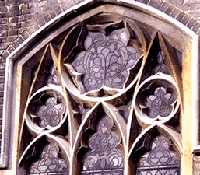 |
United Reformed Church. | |
At the junction of Nightingale Lane and Grosvenor Road. It is not only has the liturgy been reformed here but the church itself has been literally reformed also. This building was originally St Luke's Church, Kings Cross. In order to build St Pancras Station this church was dismantled brick by brick and was eventually rebuilt with a few alterations on its present site. It reopened for services in 1867. (See No. 17. on Map.) |
||
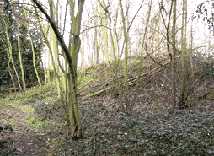  |
Wanstead House Gardens. | |
Wanstead Park about 75 yards/metres north of the Temple, there is a raised mound among the shrubbery. It is about 5 metres high and 35 metres in diameter and surrounded by a screen of young Yew trees. Wanstead House was a magnificent country house with extensive landscaped gardens. The park now occupies part of these gardens. The house stood on the high ground with a fine view down to the artificial lakes. What is now a grassy slope with trees and shrubbery either side was once an ornamental garden with intricately patterned flower beds of the French style, This pattern could only be appreciated by looking down upon it. So, two viewing points were built on raised mounts for this purpose. One is marked by the white arrow added to the initial plan of the garden shown in the lower picture. The other one is placed symmetrically on the other side of the grass slope Apart from the ornamental lakes and a few old trees, very little remains of these gardens. (See No. 18. on Map ) |
||
 |
Wanstead House Gatepost. | |
By the traffic lights at the junction of Overton Drive and Blake Hall Road. These two gateposts originally stood at the end of the drive leading to Wanstead House. The monogram is that of Sir Richard Child who later became Viscount Castlemaine and Earl Tylney, who inherited the house in 1715 and who was largely responsible for making the house so palatial. Sir Richard's father was chairman of the East India Company from which much of his great wealth was derived. (See No. 19. on Map.) |
||
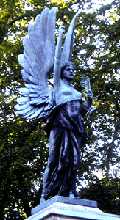 |
Wanstead War Memorial. | |
Standing at the side of Wanstead High Street in a wooded area, the monument is surmounted by a winged figure of victory. (See No. 20. on Map.) Sculptor: N. A. Trent. Erected after World War 1. |
||
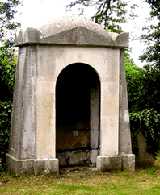 |
Watching for Body-Snatchers. | |
In the churchyard of St Mary's Church, Overton Drive, Wanstead, about 50 yards due south of the church. This small shelter was built in 1813 to mark the grave of the sculptor Joseph Wilton (1722-1803), but in the 1830s it provided shelter for the guard employed to keep watch for body-snatchers. At the end of the 18th and the beginning of the 19th centuries, it was only permitted to dissect bodies of executed criminals. This meant that only a few bodies were available, and so hospitals and medical schools used to pay sizeable sums of money for corpses for dissection. Some of these corpses were provided by grave robbers, who dug up recently buried bodies and sold them. The most notorious case occurred in Scotland when Burke and Hare committed murder to provide bodies. William Burke was executed for his crimes in 1829. During the 1820s there were a number of grave robbers based in Barking. (See No. 21. on Map.) |
||
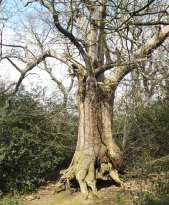 |
The Witch's Tree. | |
In Bush Wood. To find this tree take the footpath a few yards east of Friends Meeting House in Bush Road. Walk about 30 paces south from the road and then take a left turn and walk 50 paces down the bridle path to the east passing a wooden post with a white painted top. When you find a tree stump on your right, walk down a narrow path southward for 30 paces and you should come to the tree. Judging from the girth of the tree it is thought that it may be more than 500 years old. If this is so, then in 1553 it probably witnessed the future Queen Elizabeth I escorting her sister Queen Mary back to London in order for the latter to claim the throne. After the sisters had met up in Wanstead House, they must have ridden close by here. (See No. 22. on Map.) |
||
OTHER AREAS COVERED:-
|| Beckton || Bethnal Green || Blackwall || Bow || Bromley-by-Bow || Canary Wharf || Canning Town || Chingford || Cubit Town || Custom House || East Ham || East India Dock || Forest Gate || Higham's Park || Leyton || Leytonstone || Limehouse || Little Ilford || Manor Park || Mile End || Millwall || North Woolwich || Plaistow || Plashet || Poplar || St George's || St Katharine Dock || Shadwell || Shoreditch || Silvertown || Snaresbrook || Spitalfields || Stepney || Stratford || Upton || Walthamstow East || Walthamstow Village || Walthamstow West || Wapping || West India Dock || Whitechapel || Woodford || |